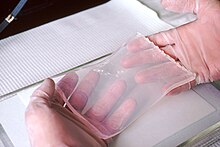




Southern blot is a method used for detection and quantification of a specific DNA sequence in DNA samples. This method is used in molecular biology. Briefly, purified DNA from a biological sample (such as blood or tissue) is digested with restriction enzymes, and the resulting DNA fragments are separated by electrophoresis using an electric current to move them through a sieve-like gel or matrix, which allows smaller fragments to move faster than larger fragments. The DNA fragments are transferred out of the gel or matrix onto a solid membrane, which is then exposed to a DNA probe labeled with a radioactive, fluorescent, or chemical tag. The tag allows any DNA fragments containing complementary sequences with the DNA probe sequence to be visualized within the Southern blot.[1]
The Southern blotting combines the transfer of electrophoresis-separated DNA fragments to a filter membrane in a process called blotting, and the subsequent fragment detection by probe hybridization.[2]
The method is named after the British biologist Edwin Southern, who first published it in 1975.[3] Other blotting methods (i.e., western blot,[4] northern blot, eastern blot, southwestern blot) that employ similar principles, but using RNA or protein, have later been named for compass directions as a sort of pun from Southern's name. As the label is eponymous, Southern is capitalized, as is conventional of proper nouns. The names for other blotting methods may follow this convention, by analogy.[5]
- ^ "Talking Glossary of Genetic Terms | NHGRI". www.genome.gov. National Institutes of Health. Retrieved 24 January 2023.
 This article incorporates text from this source, which is in the public domain.
This article incorporates text from this source, which is in the public domain.
- ^ "Southern Blot".
- ^ Southern, Edwin Mellor (5 November 1975). "Detection of specific sequences among DNA fragments separated by gel electrophoresis". Journal of Molecular Biology. 98 (3): 503–517. doi:10.1016/S0022-2836(75)80083-0. ISSN 0022-2836. PMID 1195397. S2CID 20126741.
- ^ Towbin; Staehelin, T; Gordon, J; et al. (1979). "Electrophoretic transfer of proteins from polyacrylamide gels to nitrocellulose sheets: procedure and some applications". PNAS. 76 (9): 4350–4. Bibcode:1979PNAS...76.4350T. doi:10.1073/pnas.76.9.4350. PMC 411572. PMID 388439.
- ^ Burnette, W. Neal (April 1981). "Western Blotting: Electrophoretic Transfer of Proteins from Sodium Dodecyl Sulfate-Polyacrylamide Gels to Unmodified Nitrocellulose and Radiographic Detection with Antibody and Radioiodinated Protein A". Analytical Biochemistry. 112 (2): 195–203. doi:10.1016/0003-2697(81)90281-5. ISSN 0003-2697. PMID 6266278.